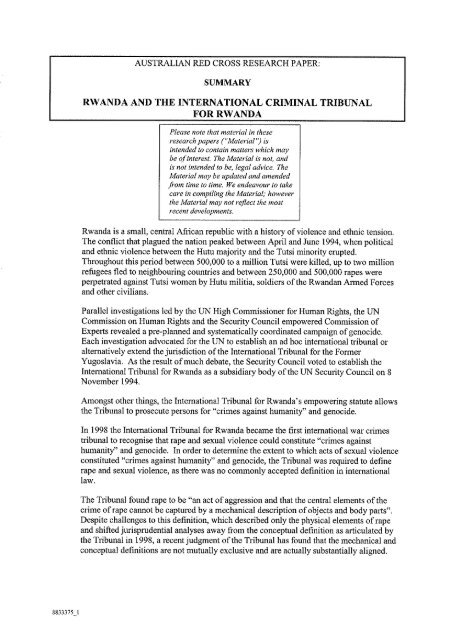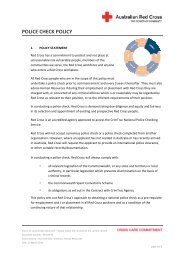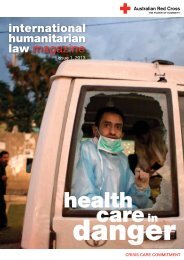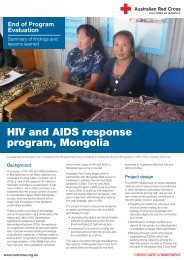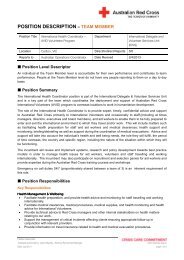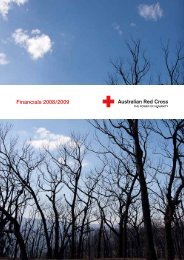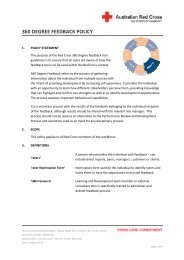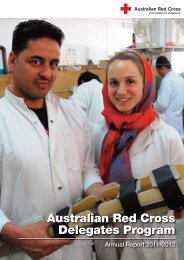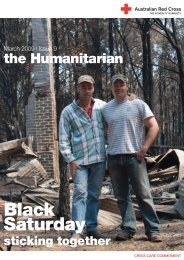2007 - The Rwandan conflict and the prosecution of rape
2007 - The Rwandan conflict and the prosecution of rape
2007 - The Rwandan conflict and the prosecution of rape
You also want an ePaper? Increase the reach of your titles
YUMPU automatically turns print PDFs into web optimized ePapers that Google loves.
AUSTRALIAN RED CROSS RESEARCH PAPER:SUMMARYRWANDA AND THE INTERNATIONAL CRIMINAL TRIBUNALFOR RWANDAPlease note that material in <strong>the</strong>seresearch papers ("Material") isintended to contain matters whích maybe <strong>of</strong> interest. <strong>The</strong> Material is not, <strong>and</strong>is not intended to be, legal advice. <strong>The</strong>Material may be updated <strong>and</strong> amendedfrom time to time. lle endeavour to takecare in compiling <strong>the</strong> Material; however<strong>the</strong> Material may not reflect <strong>the</strong> mostrecent developments.Rw<strong>and</strong>a is a small, central African republic with a history <strong>of</strong> violence <strong>and</strong> ethnic tension.<strong>The</strong> <strong>conflict</strong> that plagued <strong>the</strong> nation peaked between April <strong>and</strong> June 1994, when political<strong>and</strong> ethnic violence between <strong>the</strong> Hutu majority <strong>and</strong> <strong>the</strong> Tutsi minority erupted.Throughout this period between 500,000 to a million Tutsi were killed, up to two millionrefugees fled to neighbouring countries <strong>and</strong> between 250,000 <strong>and</strong> 500,000 <strong>rape</strong>s wereperpetrated against Tutsi women by Hutu militia, soldiers <strong>of</strong> <strong>the</strong> <strong>Rw<strong>and</strong>an</strong> Armed Forces<strong>and</strong> o<strong>the</strong>r civilians.Parallel investigations led by <strong>the</strong> UN High Commissioner for Human Rights, <strong>the</strong> UNCommission on Human Rights <strong>and</strong> <strong>the</strong> Security Council empowered Commission <strong>of</strong>Experts revealed a pre-planned <strong>and</strong> systematically coordinated campaign <strong>of</strong> genocide.Each investigation advocated for <strong>the</strong> UN to establish an ad hoc international tribunal oralternatively extend <strong>the</strong> jurisdiction <strong>of</strong> <strong>the</strong> lnternational Tribunal for <strong>the</strong> FormerYugoslavia. As <strong>the</strong> result <strong>of</strong> much debate, <strong>the</strong> Security Council voted to establish <strong>the</strong>International Tribunal for Rw<strong>and</strong>a as a subsidiary body <strong>of</strong> <strong>the</strong> UN Security Council on 8November 1994.Amongst o<strong>the</strong>r things, <strong>the</strong> International Tribunal for Rw<strong>and</strong>a's empowering statute allows<strong>the</strong> Tribunal to prosecute persons for "crimes against humanity" <strong>and</strong> genocide.In 1998 <strong>the</strong> International Tribunal for Rw<strong>and</strong>a became <strong>the</strong> first international war crimestribunal to recognise that <strong>rape</strong> <strong>and</strong> sexual violence could constitute oocrimes againsthumanity" <strong>and</strong> genocide. In order to determine <strong>the</strong> extent to which acts <strong>of</strong> sexual violenceconstituted "crimes against humanity''<strong>and</strong> genocide, <strong>the</strong> Tribunal was required to define<strong>rape</strong> <strong>and</strong> sexual violence, as <strong>the</strong>re was no commonly accepted definition in internationallaw.<strong>The</strong> Tribunal found <strong>rape</strong> to be'oan act <strong>of</strong> aggression <strong>and</strong> that <strong>the</strong> central elements <strong>of</strong> <strong>the</strong>crime <strong>of</strong> <strong>rape</strong> cannot be captured by a mechanical description <strong>of</strong> objects <strong>and</strong> body parts".Despite challenges to this definition, which described only <strong>the</strong> physical elements <strong>of</strong> <strong>rape</strong><strong>and</strong> shifted jurisprudential analyses away from <strong>the</strong> conceptual definition as articulated by<strong>the</strong> Tribunal in 1998, a recent judgment <strong>of</strong> <strong>the</strong> Tribunal has found that <strong>the</strong> mechanical <strong>and</strong>conceptual definitions are not mutually exclusive <strong>and</strong> are actually substantially aligned.8833375_l
AUSTRALIAN RED CROSS RESEARCH PAPER:RWANDA AND THE INTERNATIONAL CRIMINAL TRIBUNAL FORRWANDAExplain <strong>the</strong> background to <strong>the</strong> <strong>conflict</strong> in Rw<strong>and</strong>a <strong>and</strong> <strong>the</strong> circumstances leading to<strong>the</strong> creation <strong>of</strong> <strong>the</strong> International Criminal Tribunal for Rw<strong>and</strong>a ("ICTR")1.1BackgroundRw<strong>and</strong>a is a small central African republic with a history <strong>of</strong> violence <strong>and</strong> ethnic tension.Its population is composed <strong>of</strong> primarily three groups: Hutu, Tutsi <strong>and</strong> Twa. Each share <strong>the</strong>same language <strong>and</strong> culture, but have recognisable differences.lIn1962 a Hutu-led revolution seized <strong>Rw<strong>and</strong>an</strong> independence from <strong>the</strong>ir Belgian colonialmasters. Following <strong>the</strong> revolution, <strong>Rw<strong>and</strong>an</strong>s witnessed <strong>the</strong> mass exodus <strong>of</strong> <strong>the</strong> Tutsiminority to neighbouring countries such as Ug<strong>and</strong>a <strong>and</strong> Tanzania.1.2<strong>Rw<strong>and</strong>an</strong> Patriotic Front attackOn I October 1990 militant refugees, known as <strong>the</strong> <strong>Rw<strong>and</strong>an</strong> Patriotic Front (RPF),attacked nor<strong>the</strong>rn Rw<strong>and</strong>a from bases in Ug<strong>and</strong>a. <strong>The</strong> incumbent one-party regime <strong>of</strong>President Juvenal Habyarimana (Habyarimana), established after a military coup in1973, decided to exaggerate <strong>the</strong> RPF threat as a method <strong>of</strong> garnering dissident Hutusupport.2 Habyarimana portrayed all Tutsi as RPF collaborators <strong>and</strong> for three <strong>and</strong> a halfyears used physical as well as verbal abuse to redefine <strong>the</strong> population <strong>of</strong> Rw<strong>and</strong>a in"<strong>Rw<strong>and</strong>an</strong>s", meaning those who backed <strong>the</strong> President, <strong>and</strong> "ibyitso" or "accomplices <strong>of</strong><strong>the</strong> enemy''meaning <strong>the</strong> Tutsi minority <strong>and</strong> Hutu opposed to him.r1.3End <strong>of</strong> <strong>the</strong> monopolytn June 1991, as a result <strong>of</strong> internal political discord <strong>and</strong> intense pressure to allow politicalpluralism, <strong>the</strong> <strong>Rw<strong>and</strong>an</strong> Constitution was modified to allow multi-party democracy.Habyarimana delayed <strong>the</strong> establishment <strong>of</strong> a power sharing govemment for <strong>the</strong> next threeyears.a1.4Preparation for exterminationEarly in 1992,two political parties affiliated with Habyarimana formed militia whichwere trained <strong>and</strong> supplied by <strong>the</strong> <strong>Rw<strong>and</strong>an</strong> army (<strong>the</strong> "Interahamwe" known as Those whoSt<strong>and</strong> Toge<strong>the</strong>r or Those who Attack Toge<strong>the</strong>r <strong>and</strong> <strong>the</strong> "Impuzamubambi"). During <strong>the</strong>next two years <strong>the</strong>se militia were involved in <strong>the</strong> killing <strong>of</strong> more than 2000 civilians,I Karhilo Jaana (1995) "<strong>The</strong> Establishment <strong>of</strong> <strong>the</strong> International Tribunal for Rw<strong>and</strong>a" Nordic Journal <strong>of</strong>International Law Y ol 65, 683 -'l 13 at 6842Human Rights Watch (1999) Leave none to tell <strong>the</strong> story: Genocide in Rw<strong>and</strong>a, viewed l0 January <strong>2007</strong>Ibido Orth Rick (2001) "Rw<strong>and</strong>a's Hutu Exhemist Genocidal Insurgency: An Eyewitness Perspectiv€' Small l|lars<strong>and</strong> Insurgencies Vol l2(l),76 - 109 at 838833375_l
mostly Tutsi. s <strong>The</strong>se <strong>and</strong> o<strong>the</strong>r crimes w-ent unpunished, thus fostering a sense thatpolitical <strong>and</strong> ethnic violence was normal.6During l993,Habyarimana loyalists prepared for an attack on <strong>the</strong> minority. Recruitment<strong>and</strong> training-<strong>of</strong> <strong>the</strong> Interhamwe exp<strong>and</strong>ed, whilst a'ocivilian self - defence force" tvasestablished.T Soldiers <strong>and</strong> political leaders distributed firearms to militia, <strong>and</strong> o<strong>the</strong>rsarmed most young men with weapons such as machetes. In response to <strong>the</strong>se preparations,<strong>the</strong> RPF increased <strong>the</strong>ir number <strong>of</strong> supporters <strong>and</strong> troops.s1.5Arusha AccordsFollowing months <strong>of</strong> negotiations on 4 August lgg3,Habyarimana <strong>and</strong> <strong>the</strong> RPF signed<strong>the</strong> Arusha Accords.e This agreement was to establish <strong>the</strong> rule <strong>of</strong> law, repatriate <strong>and</strong>resettle refugees <strong>and</strong> arrange power sharing under UN supervision. However <strong>the</strong>implementation <strong>of</strong> <strong>the</strong> agreement proceeded slowly <strong>and</strong> violence continued to intensiry,resulting in fur<strong>the</strong>r casualties <strong>and</strong> displacement.1.6<strong>The</strong> GenocideUnder intense intemational pressure, Habyarimana agreed to attend a one day summit inDar es Salaam to discuss a regional approach to <strong>the</strong> <strong>Rw<strong>and</strong>an</strong> crisis. His aircraft was shotdown upon its return to Kigali airport on 6 April 1994. Within hours <strong>of</strong> <strong>the</strong> crash, a smallgroup <strong>of</strong> Hayarimana's close associates began to execute <strong>the</strong> planned extermination.l0Government troops, <strong>the</strong> presidential guard <strong>and</strong> armed militias started attacking <strong>and</strong> killingHutu government <strong>of</strong>ficials <strong>and</strong> leaders <strong>of</strong> <strong>the</strong> political opposition, thus creating a vacuumin which <strong>the</strong>y could take control.rr Soldiers <strong>and</strong> militia äiso began systematicàilyslaughtering Tutsi. Encouraged by radio propag<strong>and</strong>a, public authorities <strong>and</strong> tangibleincentives many ordinary citizens were mobilised to take part in <strong>the</strong> massacre.t2-In May <strong>and</strong> June, when <strong>the</strong> interim government was weakened by military losses <strong>and</strong> by<strong>the</strong> first signs <strong>of</strong> international disapproval, Hutu began refusing to participate in <strong>the</strong>genocide.r3 On 18 July <strong>the</strong> RPF däared victory. Tie next day it established a newgovernment <strong>of</strong> national unity.Between April <strong>and</strong> June 500 000 to a million Tutsi had been killed.'o Up to two millionrefugees, mostly Hutu, are estimated to have fled to neighbouring countries in fear <strong>of</strong>Tutsiretaliation.rs <strong>The</strong> capital city was destroyed with no utilities or góvernment infrastructure.From a total <strong>of</strong> 700 judges <strong>and</strong> lawyers, only 40 remained.165Human Rights Watch, supra6rbidTIbidI tbidetalk by Phillippe Gaillard, ICRC head <strong>of</strong> delegation in Rw<strong>and</strong>a from 1993 to 1994, Rw<strong>and</strong>a 1994: ,,La vraievie est absente", 18 October 1994, International Museum <strong>of</strong> <strong>the</strong> Red Cross <strong>and</strong> Red Crescent, Genevalo Human Rights Watch, suprar¡Ibid'2lbid r3lbidla Karhilo, supra 687rslbid16lbid8833375 I
1.7 Role <strong>of</strong> <strong>the</strong> UNIn October 1993 <strong>the</strong> peacekeeping force UN Assistance Mission for Rw<strong>and</strong>a (UNAMIR)was deployed pursuant to <strong>the</strong> Arusha Accords. <strong>The</strong> m<strong>and</strong>ate <strong>of</strong> UNAMIR was to assist<strong>the</strong> parîies in implementing <strong>the</strong> transitional arrangements as agreed. 17 After 10 Belgianpeacekeepers were killed, <strong>the</strong> Security Council voted on 21 April 1994 to scale down <strong>the</strong>operation.ls However within a week, <strong>the</strong> UN Secretary General reported that massacrescontinued on a large scale <strong>and</strong> called for 'forceful action to restore law <strong>and</strong> order'.re OnI7 May <strong>the</strong> Security Council approved <strong>the</strong> upgrading <strong>of</strong> UNAMIRs force level to 5,500<strong>and</strong> gave <strong>the</strong> force an exp<strong>and</strong>ed m<strong>and</strong>ate.Throughout <strong>the</strong> following months <strong>the</strong> Security Council authorised an arrns embargo onRw<strong>and</strong>a20 <strong>and</strong> approved <strong>the</strong> m<strong>and</strong>ate, under Chapter VII <strong>of</strong> <strong>the</strong> UN Charter, for a Frenchledmultinational-force to embark on a humanitarian mission ('Operation Turquoise').21Through <strong>the</strong> ground work <strong>of</strong> UNAMIR <strong>and</strong> Operation Turquoise <strong>the</strong> scale <strong>and</strong> speed <strong>of</strong><strong>the</strong> <strong>conflict</strong> became more widely known. <strong>The</strong> Security Council m<strong>and</strong>ated <strong>the</strong> SecretaryGeneral to report on <strong>the</strong> violations <strong>of</strong> human rights <strong>and</strong> humanitarian law committed inRw<strong>and</strong>a.22 On 8 June in its authorisation <strong>of</strong> <strong>the</strong> continued deployment <strong>of</strong> UNAMIR <strong>the</strong>Security Council rated with <strong>the</strong> gravest concern reports indicating that acts <strong>of</strong> genocidehad occurred in Rw<strong>and</strong>a <strong>and</strong> recalled that genocide constituted a crime punishable underinternational law.23<strong>The</strong> UN High Commissioner for Human Rights <strong>and</strong> <strong>the</strong> UN Commission on HumanRights took up <strong>the</strong>ir own parallel investigations. <strong>The</strong> LJN High Commissioner for Humannightr appointed a Speciál Rapporteur on Rw<strong>and</strong>a2a whose reports revealed a pre-planned<strong>and</strong> systematically coordinated campaign <strong>of</strong> genocide <strong>and</strong> advocated for <strong>the</strong> UN toestablish an ad hoc international tribunal or alternatively, extend <strong>the</strong> jurisdiction <strong>of</strong> <strong>the</strong>lnternational Tribunal for <strong>the</strong> Former Yugoslavia.2s <strong>The</strong>se reports were instrumental inestablishing <strong>the</strong> need for intemational action to bring <strong>the</strong> perpetrators to justice.1.8<strong>The</strong> Commission <strong>of</strong> ExpertsOn 1 July 1994 <strong>the</strong> Security Council empowered <strong>the</strong> Secretary General to establish animpartial Commission <strong>of</strong> Experts. In late July <strong>the</strong> Secretary General appointed threeAfrican jurists on <strong>the</strong> Commission.26 <strong>The</strong> Commission's terms <strong>of</strong> reference included anexamination <strong>of</strong> <strong>the</strong> question <strong>of</strong> <strong>the</strong> appropriate venue for proceedings against perpetrators<strong>of</strong> human rights violations.t7 tJN, Security Council Resolution 872,UN Doc. S/Res/872, adapted unanimously 5 October 199318UN, ^SecarityCouncil Resolution 9/2, UN Doc. S/Res/912, adopted unanimously 21 April 1994. <strong>The</strong> SecurityCouncil authorised <strong>the</strong> reduction <strong>of</strong> <strong>the</strong> force to 270, but <strong>the</strong> withdrawal halted at 450 troopste UN, Letter <strong>of</strong> <strong>the</strong> Secretary General to <strong>the</strong> Security Council, uN Doc. S/1994/518, 29 Apnl199420 SlRes/918, paragraphs 13-172t LIN, Security Council Resolution 929, UN Doc. S/Res/929, 27 June 199422tIN Doc. S/Res/918, 17 May 1994, para l8t3 LIN, Security Council Resolution 925,UN Doc. S/Res/925, 8 June 1994to LrNI, Report <strong>of</strong> <strong>the</strong> Commßsion on Human Rights on its Third Special Session, UN Doc. E/C N. 415-311,30May 1994, pp.4-825tÑ, Report on <strong>the</strong> situation <strong>of</strong> human rights in Rw<strong>and</strong>a submitted by Mr R. Degrri Segui, Special Rapporteur<strong>of</strong> <strong>the</strong> Commission on Human Rights, UN Doc. E/CN 4/1995 /7,28 June 199426Mr Atsu-K<strong>of</strong>fi Amega <strong>of</strong> Togo as Chairman, Mrs Mabi Dieng <strong>of</strong> Guinea <strong>and</strong> Pr<strong>of</strong>essor Salifou Fomba <strong>of</strong> Malias members. lJN, Letter Dated 29 Juty 1994 from <strong>the</strong> Secretary General Addressed to <strong>the</strong> President <strong>of</strong> <strong>the</strong>Security Council, UN Doc. Sl 19941906, 29 luly 19948833375 I
In accordance with it's m<strong>and</strong>ate,2T <strong>the</strong>Rw<strong>and</strong>a Commission received <strong>and</strong> reviewedmaterial from govemments, human rights organisations <strong>and</strong> aid agencies <strong>and</strong> conductedtwo visits to <strong>the</strong> region. It produced a preliminary report containing findings <strong>of</strong> violations<strong>of</strong> human rights, humanitarian law, crimes against humanity <strong>and</strong> specific euidence <strong>of</strong> <strong>the</strong>crime <strong>of</strong> genocide.2s <strong>The</strong> Commission u.gu.d strongly in fâvour óf extending <strong>the</strong>jurisdiction <strong>of</strong> <strong>the</strong> International Criminal Tribunal for Yugoslavia to include <strong>the</strong>international crimes committed in Rw<strong>and</strong>a.1.9JurisdictionDuring <strong>the</strong> autumn <strong>of</strong> ß94 <strong>the</strong>re was much debate over whe<strong>the</strong>r <strong>prosecution</strong> <strong>of</strong> thoseimplicated in <strong>the</strong> <strong>Rw<strong>and</strong>an</strong> genocide should take place before an international tribunal orbefore <strong>Rw<strong>and</strong>an</strong> courts.2e Although keen to have <strong>the</strong> trials held in Rw<strong>and</strong>a, <strong>the</strong> <strong>Rw<strong>and</strong>an</strong>govemment pursued <strong>the</strong> setting up <strong>of</strong> an international tribunal, largely due to <strong>the</strong> enormity<strong>of</strong> <strong>the</strong> task <strong>and</strong> <strong>the</strong> near complete destruction <strong>of</strong> <strong>the</strong> local judiciary. In September <strong>the</strong>government requested <strong>the</strong> Security Council set up an international tribunal for Rw<strong>and</strong>a.3oAs a member <strong>of</strong> <strong>the</strong> Security Council, it <strong>the</strong>n participated in <strong>the</strong> drafting <strong>of</strong> an enablingresolution <strong>and</strong> Statute for <strong>the</strong> new Tribunal.<strong>The</strong> Security Council voted to establish an international tribunal for Rw<strong>and</strong>a as asubsidiary body <strong>of</strong> <strong>the</strong> UN Security Council on 8 November 1994. Acting under ChapterVII <strong>of</strong> <strong>the</strong> UN Charter, <strong>the</strong> Security Council established <strong>the</strong> tribunal for <strong>the</strong> oosole purpose<strong>of</strong> prosecuting persons responsible for genocide <strong>and</strong> o<strong>the</strong>r such violations <strong>of</strong> internatiónalhumanitarian law committed in <strong>the</strong> territory <strong>of</strong> Rw<strong>and</strong>a <strong>and</strong> <strong>Rw<strong>and</strong>an</strong> citizens responsiblefor genocide <strong>and</strong> o<strong>the</strong>r such violations committed in <strong>the</strong> territory <strong>of</strong> neighbouring States,between I January 1994 <strong>and</strong> 3l December 1994.3r <strong>The</strong> Statute <strong>of</strong> <strong>the</strong> tribunal wasadopted as an appendix to <strong>the</strong> resolution.<strong>The</strong> Security Council Resolution was adopted with 13 votes in favour <strong>and</strong> one abstention(China). In spite <strong>of</strong> having initially called for <strong>the</strong> Tribunal to be set up, Rw<strong>and</strong>a votedagainst <strong>the</strong> adoption <strong>of</strong> Resolution 955. <strong>The</strong> new govemment argued that amongst o<strong>the</strong>rthings <strong>the</strong> temporal jurisdiction <strong>of</strong> <strong>the</strong> Tribunal was too limited <strong>and</strong> would not cõver <strong>the</strong>lengtþ period during which preparations were made for <strong>the</strong> genocide; <strong>and</strong>, that itscomposition, with only two trial chambers, would prevent it from functioning properly inview <strong>of</strong> <strong>the</strong> large number <strong>of</strong> <strong>prosecution</strong>s to be brought.32 Never<strong>the</strong>less, on tñã aáyfollowing <strong>the</strong> adoption <strong>of</strong> <strong>the</strong> resolution Vice-President Paul Kagame announced hisgovernment's intention to cooperate with <strong>the</strong> new Tribunal.l]q*,Sscyity Council Resolution 935,UN Doc. S/Res/935, adopted unanimously I July 1994'" UN, Preliminary Report <strong>of</strong> <strong>the</strong> Commission <strong>of</strong> Experts established pursuant to Security Council Resolution935 (1994), UN Doc. S/1994/tt25,4 Oct t9942eKarhilo, supra 69430Lnl, Letter dated 28 September 1994from <strong>the</strong> Permanent Representative <strong>of</strong> Rw<strong>and</strong>a Addressed to <strong>the</strong>President <strong>of</strong> <strong>the</strong> Security Council, UN Doc Sll9g4/ll15, 28 Sept. 1994:l tlN, Security Council Resolution 955, UN Doc. S/Res/9SS, B Nov 199432Aptel, Cecile (lgg7) "<strong>The</strong> International Criminal Tribunal for Rw<strong>and</strong>a" <strong>The</strong> International Review <strong>of</strong> <strong>the</strong> RedCross Vol 321,675 - 6838833375 I
<strong>The</strong> ICTR Akayesu Case (1998) was groundbreaking in <strong>the</strong> Trial Chamber's analysis<strong>of</strong> <strong>the</strong> crimes <strong>of</strong> genocide <strong>and</strong> sexual violence. Specilically <strong>the</strong> Chamber found that<strong>rape</strong> constituted an international crime. <strong>The</strong> Tribunal has since prosecuted for <strong>rape</strong><strong>and</strong> sexual violence crimes in key cases including <strong>the</strong> Muhímøna Case (2005), <strong>and</strong> isresponsible for developing important case law in this area.Focussing on <strong>the</strong> Akøyesu Case <strong>and</strong><strong>the</strong> Muhímana Case, discuss how <strong>the</strong> Tribunalhas defined international crimes <strong>of</strong> <strong>rape</strong> <strong>and</strong> sexual violence.2.1Rape <strong>and</strong> sexual violence during <strong>the</strong> <strong>conflict</strong>Throughout <strong>the</strong> <strong>Rw<strong>and</strong>an</strong> genocide <strong>rape</strong> <strong>and</strong> sexual violence, including mutilation <strong>and</strong>sexual slavery were perpetrated against Tutsi women by Hutu militia, soldiers <strong>of</strong> <strong>the</strong><strong>Rw<strong>and</strong>an</strong> Armed ForceJ<strong>and</strong> o<strong>the</strong>r civilians.33 Military <strong>and</strong> political leaders at all levelsinstigated, directed, encouraged <strong>and</strong> engaged in this violence to fur<strong>the</strong>r <strong>the</strong>ir systemiccampaign to destroy, in whole or in part, <strong>the</strong> Tutsi community. <strong>The</strong> <strong>rape</strong>s <strong>and</strong> sexualviolence perpetrated were used as political <strong>and</strong> military tools to terrorise <strong>the</strong> minoritygroup.34 <strong>The</strong> Special Rapporteur on <strong>the</strong> situation <strong>of</strong> human rights in Rw<strong>and</strong>a stated that"[a]ccording to^consistent <strong>and</strong> reliable testimony...<strong>rape</strong> was <strong>the</strong> rule <strong>and</strong> its absence was<strong>the</strong> exception."j)2.2LawArticle 3(g), 3(i) <strong>of</strong> <strong>the</strong> Statute <strong>of</strong> <strong>the</strong> International Tribunal for Rw<strong>and</strong>a gives <strong>the</strong> powerto <strong>the</strong> Tribunal to prosecute persons for "<strong>rape</strong>" <strong>and</strong> "o<strong>the</strong>r inhumane acts" whencommitted as part <strong>of</strong> a widespread or systematic attack against any civilian population onnational, political, ethnic, racial or religious ground. Artícle 4(e) allows <strong>prosecution</strong> for"outrages against human dignity, in particular humiliating <strong>and</strong> degrading treatment, <strong>rape</strong>,enforced prostitution <strong>and</strong> any form <strong>of</strong>indecent assault". <strong>The</strong>se <strong>of</strong>fences are broadlyrefened to as "crimes against humaniry".Article 6 (1) <strong>of</strong> <strong>the</strong> Statute deems that those who "planned, instigated, ordered, committedor o<strong>the</strong>rwise aided or abetted in <strong>the</strong> planning, preparation or execution <strong>of</strong> a crime referredto in Articles 2 to 4 <strong>of</strong> <strong>the</strong> statute, shall be individually responsible for <strong>the</strong> crime". Article6(3) provides that "acts committed by a subordinate will not relieve his or her superior <strong>of</strong>criminal responsibility if he or she had reason to know that <strong>the</strong> subordinate was about tocommit such an act or has done so <strong>and</strong> <strong>the</strong> superior failed to take <strong>the</strong> necessary <strong>and</strong>reasonable measures to prevent such acts or punish <strong>the</strong> perpetrators".2.3Akøyesas6 - FactsJean Paul Akayesu served as "bourgmsstre" <strong>of</strong> <strong>the</strong> Taba commune from April 1993 untilJune 1994. As bourgmestre, Akayesu had exclusive control over <strong>the</strong> commune <strong>and</strong> <strong>the</strong>33Although <strong>the</strong> exact number <strong>of</strong> women <strong>rape</strong>d will never be known, it is estimated that between 250,000 <strong>and</strong>500,000 *pes occut"d.See Special Rapporteur <strong>of</strong> <strong>the</strong> Commission on Human Rights Report on <strong>the</strong> Situation <strong>of</strong>Human Rights in Rw<strong>and</strong>ø Un Doc. Ê,1CN.411996168 (Jan 29,1996)3a Press Release, Human Rights Watch (1993) Human Rights l{atch Applauds Rw<strong>and</strong>a Rape Verdict: Setsinternational Precedentþr Punishing Sexual Violence as a W'ar Crime,2 September, viewed 7 February <strong>2007</strong>,available at http://www.hrw.ordpress9S/sept/r<strong>rape</strong>902.htm35Special Rapporteur <strong>of</strong> <strong>the</strong> Commission on Human Rights Report on <strong>the</strong> Situation <strong>of</strong> Human Rights in Rw<strong>and</strong>aUn Doc. ElCN.4ll996l68 (Jan 29,1996') at paragraph l636 <strong>The</strong> Prosecutor v Jean-Paul Akayesu Case No ICTR-1996-4-T, Judgment TC),2 September 1998 (ICTRReports, 1998, pp 44 - 404) ('Akayesu")8833375 I
communal police. He was responsible for <strong>the</strong> territorial administration <strong>of</strong> <strong>the</strong> commune,along with maintaining laws <strong>and</strong> public order.From April to June 1994 at least 2000 Tutsis were killed in <strong>the</strong> Taba commune whileAkayesu was in power. <strong>The</strong> killings were so open <strong>and</strong> widespread that it was alleged thatAkayesu must have known about <strong>the</strong>m <strong>and</strong> had <strong>the</strong> authority <strong>and</strong> responsibility to prevent<strong>the</strong> killings, but failed to do so. Many civilians (mostly Tutsi) sought refuge at <strong>the</strong> BureauCommunal during this period. While seeking refuge it was alleged that female civilianswere regularly taken by armed local militia or <strong>the</strong> communal police <strong>and</strong> subjected to <strong>rape</strong><strong>and</strong> sexual violence. <strong>The</strong> <strong>prosecution</strong> claimed that Akayesu knew <strong>of</strong> <strong>the</strong> sexual violence,beatings <strong>and</strong> murder <strong>and</strong> facilitated <strong>the</strong>m by allowing <strong>the</strong>m to occur on or near <strong>the</strong> BureauCommunal premises.2.4Akayesu - Decision <strong>of</strong> <strong>the</strong> Tribunal<strong>The</strong> Tribunal found that Akayesu aided <strong>and</strong> abetted multiple acts <strong>of</strong> sexual violence byallowing <strong>the</strong>m to take place on or near <strong>the</strong> premises <strong>of</strong> <strong>the</strong> Bureau Communal. Hefacilitated <strong>the</strong> commission <strong>of</strong> <strong>the</strong>se acts through his words <strong>of</strong> encouragement, which sent aclear signal <strong>of</strong> <strong>of</strong>ficial tolerance for sexual violence, without which <strong>the</strong> acts would nothave taken place.37 He was found to be individually criminally responsible for <strong>the</strong> <strong>rape</strong>s<strong>and</strong> sexual violence <strong>and</strong> to have committed acts <strong>of</strong> genocide.3s<strong>The</strong> deJìnítíon <strong>of</strong> røpeIn order to determine <strong>the</strong> extent to which acts <strong>of</strong> sexual violence constituted "crimesagainst humanity", <strong>the</strong> Tribunal needed to define'o<strong>rape</strong>" as <strong>the</strong>re was no commonlyaccepted definition in international law.<strong>The</strong> Tribunal recognised that <strong>rape</strong> has been historically defined in national jurisdictions as"non-consensual sexual intercourse". <strong>The</strong> Tribunal viewed this description toomechanical, ins<strong>of</strong>ar that variations on <strong>the</strong> form <strong>of</strong> <strong>rape</strong> may also include acts whichinvolve <strong>the</strong> insertion^<strong>of</strong> objects <strong>and</strong> /or <strong>the</strong> use <strong>of</strong> bodily orifices not considered to beintrinsically sexual.3e<strong>The</strong> Tribunal defïned <strong>rape</strong> as "an act <strong>of</strong> aggression <strong>and</strong> that <strong>the</strong> central elements <strong>of</strong> <strong>the</strong>crime <strong>of</strong> <strong>rape</strong> cannot be captured by a mechanical description <strong>of</strong> objects <strong>and</strong> body parts".a0It found <strong>rape</strong> to be "a physical invasion <strong>of</strong> a sexual nature, committed on a person undercircumstances which are coercive".4l<strong>The</strong> Convention against Torture <strong>and</strong> O<strong>the</strong>r Cruel, Inhuman <strong>and</strong> Degrading Treatment orPunishment does not stipulate specific acts which constitute torture. This allowed <strong>the</strong>Tribunal to find that in certain circumstances <strong>rape</strong> may constitute a form <strong>of</strong> torture for <strong>the</strong>purposes <strong>of</strong> criminal liability. <strong>The</strong> Tribunal found <strong>rape</strong> to be akin to torture in that it is"used for such purposes as intimidation, degradation, humiliation, discrimination,punishment, control or destruction <strong>of</strong> a person".a2 <strong>The</strong> Tribunal held that "[]ike torture,<strong>rape</strong> is a violation <strong>of</strong> personal dignity, <strong>and</strong> <strong>rape</strong> in fact constitutes torture when inflicted3t I¿ [eg¡]3sldUsql3er¿ [oao]oor¿ [sgz]4' Id [o¡z]o2td¡ssl18833375_l6
y or at <strong>the</strong> instigation <strong>of</strong> or with <strong>the</strong> consent or acquiescence <strong>of</strong> a public <strong>of</strong>Ïicial or o<strong>the</strong>rpêrsott acting in ãn <strong>of</strong>ficial capacity."a3<strong>The</strong> definítíon <strong>of</strong> sexual øssaaltSexual violence (which includes <strong>rape</strong>) was defìned as "any act <strong>of</strong> a sexual nature which iscommitted on a person under circumstances which are coercive". <strong>The</strong> Tribunal found that<strong>the</strong> act must be committed:(i)(ii)as part <strong>of</strong> a wide spread or systematic attack;on a civilian population; <strong>and</strong>(iiÐ on certain catalogued discriminatory grounds, namely: national, ethnic,political, racial or religious grounds.aa<strong>The</strong> Tribunal held that sexual violence was not limited to physical invasion <strong>of</strong> <strong>the</strong> body<strong>and</strong> may include acts which do not involve penetration or even physical contact,-such as<strong>the</strong> ordering <strong>of</strong> a girl to undress <strong>and</strong> do gymnastics naked in a public courtyard.as <strong>The</strong>Tribunal described three ways by which acts <strong>of</strong> sexual violence could be prosecuted under<strong>the</strong> Statute - sexual violence falls within <strong>the</strong> scope <strong>of</strong> "o<strong>the</strong>r inhumane acts" set forth inArticle 3(i), "outrages upon human dignity" set forth in Article 4(e) <strong>and</strong> "serious bodily ormental hann" set forth in erticte 2(2)(b) <strong>of</strong> <strong>the</strong> Statute.46<strong>The</strong> meøníng <strong>of</strong> coercíon<strong>The</strong> Tribunal found coercion to be a key requirement for <strong>the</strong> <strong>of</strong>fences <strong>of</strong> <strong>rape</strong> <strong>and</strong> sexualviolence. It held that coercion need not be evidenced by a show <strong>of</strong>physical force."Threats, intimidation, exertion <strong>and</strong> o<strong>the</strong>r forms <strong>of</strong> duress which prey on fear ordesperation may constitute coercion".aT <strong>The</strong> Tribunal went on to say that "coercion may.^be inherent in certain circumstances, such as armed <strong>conflict</strong> or <strong>the</strong> military presence..."48Røpe ønd sexual víolence constítute genocíde<strong>The</strong> Tribunal found that sexual violence was an integral part <strong>of</strong> <strong>the</strong> genocide in Rw<strong>and</strong>a.In doing so, <strong>the</strong> ICTR became <strong>the</strong> first international war crimes tribunal to recognise that<strong>rape</strong> <strong>and</strong> sexual violence could,constitute genocide in <strong>the</strong> same way as any o<strong>the</strong>r act as long as <strong>the</strong>y werecommitted with <strong>the</strong> specifi.c intent to destroy, in <strong>the</strong> whole or in part, a particulargroup, targeted as such. [RJape <strong>and</strong> sexual violence certainly constitute infliction<strong>of</strong> serious bodily <strong>and</strong> mental harm on <strong>the</strong> victims [<strong>and</strong> isJ one <strong>of</strong> <strong>the</strong> worst[toJ tnfltct harrn on <strong>the</strong> victim as he or she suffers both bodily <strong>and</strong> mental harm."43l¿ [sgz]44t¿ [sgg]45l¿ [oas]o6t¿ [oss]n rd [oes]o8r¿ [ogg]4era ¡zlt18833375_l
<strong>The</strong> Tribunal found that:<strong>the</strong> acts <strong>of</strong> <strong>rape</strong> <strong>and</strong> sexual violence ...were committed solely agaínst Tutsíwomen, many <strong>of</strong> whom were subjected to <strong>the</strong> worst public humiliqtion, mutilated<strong>and</strong> <strong>rape</strong>d by more than one assailant. <strong>The</strong>se <strong>rape</strong>s resulted in physícal <strong>and</strong>psychological destruction <strong>of</strong> <strong>the</strong> Tutsi women, <strong>the</strong>irfamilies <strong>and</strong> <strong>the</strong>ircommunitíes. sexual violence was an integral part <strong>of</strong> <strong>the</strong> process <strong>of</strong> <strong>the</strong>destruction, specifically targeting Tutsi women <strong>and</strong> specifically contributing to<strong>the</strong>ir destruction <strong>and</strong> to <strong>the</strong> destructíon <strong>of</strong> <strong>the</strong> Tutsi group as a whole."So<strong>The</strong> acts <strong>of</strong> <strong>rape</strong> satisfied <strong>the</strong> systematic requirement which is <strong>the</strong> foundation <strong>of</strong> <strong>the</strong> crime<strong>of</strong> genocide. Rape was perpetrated against all Tutsi women <strong>and</strong> solely against <strong>the</strong>m.slTutsi women were presented as sexual objects <strong>and</strong> Akayesu was a participant in this. <strong>The</strong>sexual violence committed against <strong>the</strong> Tutsi woman was a step in <strong>the</strong> destruction <strong>of</strong> <strong>the</strong>Tutsi group. It was a "destruction <strong>of</strong> <strong>the</strong> spirit, <strong>of</strong> <strong>the</strong> will to live <strong>and</strong> <strong>of</strong> life itself'.522.5Challenging Akayesu<strong>The</strong> definítíon <strong>of</strong> <strong>rape</strong><strong>The</strong> concepn¡al definition <strong>of</strong> <strong>rape</strong> pronounced inAkayesu was first challenged inKunarac".In Kunarac <strong>the</strong> International Criminal Tribunal for Yugoslavia ("ICTY") TrialChamber II referred to <strong>the</strong> Akayesu definition <strong>of</strong>.<strong>rape</strong> <strong>and</strong> tacitly accepted it, but <strong>the</strong>n wenton to articulate <strong>the</strong> elements <strong>of</strong> <strong>rape</strong> as follows:54<strong>The</strong> actus reus <strong>of</strong> <strong>the</strong> crime <strong>of</strong> <strong>rape</strong> in international løw is constituted by <strong>the</strong>sexual penetration, however slight :(a) <strong>of</strong> <strong>the</strong> vagina or anus <strong>of</strong> <strong>the</strong> victim by <strong>the</strong> penis <strong>of</strong> <strong>the</strong> perpetrator or any o<strong>the</strong>robject used by <strong>the</strong> perpetrator; or(b) <strong>of</strong> <strong>the</strong> mouth <strong>of</strong> <strong>the</strong> víctim by <strong>the</strong> penis <strong>of</strong> <strong>the</strong> perpetrator; where such sexualpenetration occurs without <strong>the</strong> consent <strong>of</strong> <strong>the</strong> victim, Consentþr this purposemust be consent given voluntarily, as a result <strong>of</strong> <strong>the</strong> victim'sfree will, assessed ín<strong>the</strong> context <strong>of</strong> <strong>the</strong> surrounding circumstances.<strong>The</strong> mens rea is <strong>the</strong> intention to effect this sexual penetration, ønd <strong>the</strong> btowledgethat it occurs without <strong>the</strong> consent <strong>of</strong> <strong>the</strong> victim.<strong>The</strong> ICTY Appeals Chamber later affirmed this'odefinition".55 Although not binding on<strong>the</strong> ICTR trial or appeals chambers, this narrower Kunarac definition held persuasiveauthority with regards to <strong>the</strong> definition <strong>of</strong> <strong>rape</strong> <strong>and</strong> was adopted in subsequentjurisprudence <strong>of</strong> <strong>the</strong> ICTR Trial Chambers. In Semanzas6, Kajetíjelió7 <strong>and</strong> Kamuh<strong>and</strong>ass50r¿ [z:l]stn?zzlttrcUlzls3Prosecutor v Dragoliub Kunarac et al CaseNo IT-96-23-T <strong>and</strong>96-23/1, Judgment (TC),22February 2001('Kunarac")54Id ¡4601, [437], approvedin Prosecutorv Dragoljub Kunarac et al, CaseNo IT-96-23-T <strong>and</strong>96-23/1,Judgement (AC), 12 June2002 at [l28] ("Kunarac Appeal")" Kunarac appeal at[127 -128]'o <strong>The</strong> Prosecutor v Laurent semanza case No., IcrR-1997-20-T, Judgment (TC), 15 May 2003s7 <strong>The</strong> Prosecutor v Juvenal Kajelijeti, Case Nó. ICTR-1998-444-T, JudgmeÀt un¿ S.nt"nce (TC), I December20038833375 I
<strong>the</strong> ICTR Trial Chamber described only <strong>the</strong> physical elements <strong>of</strong> <strong>rape</strong> <strong>and</strong> shiftedjurisprudential analyses away from <strong>the</strong> conceptual definition <strong>of</strong> <strong>rape</strong> an enunciated inAkaeysu.seHowever, in <strong>the</strong> recent judgment, Muhimana60, Trial Chamber III re-exp<strong>and</strong>ed <strong>the</strong>definition <strong>of</strong> <strong>rape</strong> under international criminal law. <strong>The</strong> Chamber considered thatKunarac was "ãctually substantially aligned"6l to <strong>the</strong> Akayseu definition <strong>and</strong> stated that:<strong>the</strong> Akayseu definition <strong>and</strong> <strong>the</strong> Kunarac elements are not incompatible orsubstantially dffirent in application.llhereas Aknyesu reþted broadly to a"physical invasion <strong>of</strong> a sexual nature", Kunarac went on to articulate <strong>the</strong>parameters <strong>of</strong> what would constitute a physical invasion <strong>of</strong> a sexual natureamounting to <strong>rape</strong>o"<strong>The</strong> Trial Chamber found <strong>the</strong> accused guilty <strong>of</strong> <strong>rape</strong> as both an act <strong>of</strong> genocide <strong>and</strong> acrime against humanity.<strong>The</strong> relationship between consent <strong>and</strong> coercionIn Kunarac <strong>the</strong> Appeals Chamber recognised, as articulated,in Akayesu, that coercionprovides clear evidence <strong>of</strong> non-consent. <strong>The</strong> Appeals Chamber explained that whilst <strong>the</strong>Trial Chamber focused on <strong>the</strong> absence <strong>of</strong> consent as <strong>the</strong> essential element <strong>of</strong> <strong>rape</strong>, it didnot "disavow <strong>the</strong> Tribunal's earlier jurisprudence , but instead sought to explain <strong>the</strong>evidence between force <strong>and</strong> consent"63. <strong>The</strong> Appeals Chamber opined that whilst force or<strong>the</strong> threat <strong>of</strong> force provides clear evidence <strong>of</strong> <strong>rape</strong>, it is not a constituent element. <strong>The</strong>reare o<strong>the</strong>r factors which would render <strong>the</strong> act <strong>of</strong> sexual penetration non-consensual.ln Muhimanø <strong>the</strong> Trial Chamber reinforced Aknyesu by stating that'ocoercion is anelement that may obviate <strong>the</strong> relevance <strong>of</strong> consent as an evidentiary factor in <strong>the</strong> crime <strong>of</strong><strong>rape</strong>".64 It fur<strong>the</strong>r articulated that "most cases charged under international criminallaw...will be almost universally coercive, thus vitiating true consent."65ConclusionMuhimana is cunently on appeal in <strong>the</strong> ICTR. Whilst <strong>the</strong> Trial chamber has realignedjurisprudential analyses with <strong>the</strong> groundbreaking conceptual definition as articulated inAkayesu, it remains to be seen whe<strong>the</strong>r subsequent Chambers in both <strong>the</strong> ICTY <strong>and</strong> <strong>the</strong>ICTR adopt <strong>the</strong> reasoning <strong>of</strong> <strong>the</strong> Trial Chamber in Muhímana.s8 <strong>The</strong> Prosecutor v Jean de Dieu Kamuh<strong>and</strong>a, Case No. ICTR-1999-544-T, Judgment <strong>and</strong> Sentence (TC),22January2004se See Prosecutor v Zejnil Delalíc et al, Case No IT-96-21-A', Judgement (TC), 16 November 1998 at Í478 - 479160 <strong>The</strong> Prosecutorv Mikaeli Muhimana, Case No ICTR-95-lB-T, 28 April2005 ("Muhimana")6trd ¡s+01ó2ra ¡sso163Kunarac appeal, supra [129 - 130]e Muhimana, supra [546]ó5r¿ [s+o]8833375_l


